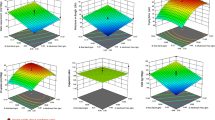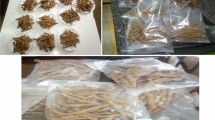Abstract
Vacuum impregnation (VI) stands as an innovative technique, used to create novel food formulations by impregnating vital nutritive compounds into natural food matrices. Process variables were syrup temperature ranging from (50 to 70 °C), syrup concentration (60° to 80° Brix), and VI duration (10 to 20 min). The optimal conditions emerged at 66.81 °C for syrup temperature, 71.58° Brix for syrup concentration, and a precise 11.59 min for the VI duration. At these paramount conditions, the candy exhibited striking attributes such as 50.0% water loss, 12.23% sugar gain, chewiness of 9 N, and lightness value of 22.17. The predicted values using the developed model were validated with experimental data and indicated the adequacy of the generated model. The functional characterization of the optimized nutmeg rind candy showcased a marked reduction in myristicin content, signifying an augmented level of safety for consumption. Furthermore in-vitro anti-bacterial assay, total phenolics, flavonoids and tannin content, anti-oxidant potential, proximate composition and microstructure of the optimized candy were analysed.




Similar content being viewed by others
Data availability
The data that support the findings of this study are available from the corresponding author upon reasonable request.
Code availability
Not applicable.
Abbreviations
- VI:
-
Vacuum impregnation
- RSM:
-
Response surface methodology
- FCCCD:
-
Face centered centre composite design
- WL:
-
Water loss
- SG:
-
Sugar gain
- NCCLS:
-
National committee for clinical laboratory standards
- SEM:
-
Scanning electron microscopy
References
Abalos RA, Naef EF, Aviles MV, Gomez MB (2020) Vacuum impregnation: a methodology for the preparation of a ready-to-eat sweet potato enriched in polyphenols. LWT Food Sci Technol 131:109773
Aliakbarlu J, Mohammadi S, Khalili SJ (2014) A study on antioxidant potency and antibacterial activity of water extracts of some spices widely consumed in the Iranian diet. Food Biochem 38(2):159–166
Barragan-Iglesias J, Rodríguez-Ramírez J, Sablani SS, Mendez-Lagunas LL (2019) Texture analysis of dried papaya (Carica papaya L.) pretreated with calcium and osmotic dehydration. Dry Technol 37(7):906–919
Bellary AN, Indiramma AR, Prakash M, Baskaran R, Rastogi NK (2016) Anthocyanin infused watermelon rind and its stability during storage. Innov Food Sci Emerg Technol 33:554–562
Bergara-Almeida S, Aparecida M, Da Silva AP (2002) Hedonic scale with reference: performance in obtaining predictive models. Food Qual Prefer 13(1):57–64
Chafer M, Gonzalez-Martinez C, Fernandez B, Perez L, Chiralt, (2003) Effect of blanching and vacuum pulse application on osmotic dehydration of pear. Food Sci Technol Int 9(5):321–328
Correa JLG, Pereira LM, Vieira GS, Hubinger MD (2010) Mass transfer kinetics of pulsed vacuum osmotic dehydration of guavas. J Food Eng 96(4):498–504
de Medeiros RAB, da Silva Júnior EV, da Silva JHF, Neto ODCF, Brandão SCR, Barros ZMP, Azoubel PM (2019) Effect of different grape residues polyphenols impregnation techniques in mango. J Food Eng 262(5):1–8
Ehrenpreis JE, DesLauriers C, Lank P, Armstrong PK, Leikin JB (2014) Nutmeg poisonings: a retrospective review of 10 years’ experience from the Illinois Poison center, 2001–2011. J Med Toxicol 10:148–151
Fang Z, Zhang Y, Lü Y, Ma G, Chen J, Liu D, Ye X (2009) Phenolic compounds and antioxidant capacities of bayberry juices. Food Chem 113(4):884–888
Gonzalez-Perez JE, Jimenez-Gonzalez O, Ramirez-Corona N, Guerrero-Beltran JA, Lopez-Malo A (2022) Vacuum impregnation on apples with grape juice concentrate: effects of pressure, processing time, and juice concentration. Innov Food Sci Emerg Technol 77:1–12
Gupta R, Singh B, Shivhare US (2012) Optimization of osmo-convective dehydration process for the development of honey-ginger candy using response surface methodology. Dry Technol 30(7):750–759
Islam MZ, Das S, Monalisa K, Sayem ASM (2019) Influence of osmotic dehydration on mass transfer kinetics and quality retention of ripe papaya (Carica papaya L) during drying. Agric Eng 1(2):220–234
Kaur P, Zalpouri R, Singh M, Verma S (2020) Process optimization for dehydration of shelled peas by osmosis and three-stage convective drying for enhanced quality. J Food Process 44(12):e14983
Koocheki A, NassiriMahallati M, Moradi R, Mansoori H (2014) Optimizing water, nitrogen and crop density in canola cultivation using response surface methodology and central composite design. Soil Sci Plant Nutr 60(2):286–298
Kuo CH, Lin J, Huang CY, Hsieh SL, Li S, Kuo JM, Shieh C (2018) Predicting sugar content of candied watermelon rind during osmotic dehydration. J Food Sci Technol 38:228–235
Min BS, Cuong TD, Hung TM, Min BK, Shin BS, Wou MH (2011) Inhibitory effect of lignans from Myristica fragrans on LPS-induced NO production in RAW 264,7 cells. Bull Korean Chem Soc 32:4059–4062
Mini Raj N, Vikram HC, Philip M, Deepa ET (2017) Fruit rind constituents in nutmeg (Myristica fragrans) morphotypes. J Plant Crop 44(3):153
Mujica-Paz H, Valdez-Fragoso A, Lopez-Malo A, Palou E, Welti-Chanes J (2003) Impregnation and osmotic dehydration of some fruits: effect of the vacuum pressure and syrup concentration. J Food Eng 57(4):305–314
Mundada M, Hathan BS, Maske S (2011) Mass transfer kinetics during osmotic dehydration of pomegranate arils. J Food Sci 76(1):E31–E39
Pereira LM, Ferrari CC, Mastrantonio SDS, Rodrigues ACC, Hubinger MD (2006) Kinetic aspects, texture, and colour evaluation of some tropical fruits during osmotic dehydration. Dry Technol 24(4):475–484
Putsakum G, Rahman N, Kamilah H, Mahmood K, Ariffin F (2020) The effects of blanching pre-treatments and immersion of sodium metabisulfite/citric acid solution on the myristicin content and the quality parameter of nutmeg (Myristica fragrans) pericarp. J Food Meas Charact 14(6):3455–3461
Rahman N, Xin TB, Kamilah H, Ariffin F (2017) Effects of osmotic dehydration treatment on volatile compound (Myristicin) content and antioxidants property of nutmeg (Myristica fragrans) pericarp. J Food Sci Technol 55:183–189
Schandrel SH (1970) Methods in Food Analysis. Academic Press, New York
Sharma N, Khanna R (2013) Modelling and multiresponse optimization on WEDM for HSLA by RSM. J Adv Manuf Technol 67:2269–2281
Shields R, Burnett W (1960) Determination of protein-bound carbohydrate in serum by modified anthrone method. Anal Chem 32(7):885–886
Silva KS, Garcia CC, Amado LR, Mauro MA (2015) Effects of edible coatings on convective drying and characteristics of the dried pineapple. Food Bioproc Tech 8(7):1465–1475
Alajlouni AM (2017) Mode of action-based risk assessment of the botanical food-borne alkenyl benzenes apiol and myristicin (Doctoral dissertation, Wageningen University and Research)
AOAC (2003) Official Methods of Analysis of AOAC, 17th edn. Association of official analytical chemists, Gaithersburg, MD, USA
Suwarda R, Suneth RF, Wahid, Sondari D (2021) Potential and opportunities of nutmeg pericarp as functional foods. E3S Web Conferences 306:1–11
Acknowledgements
The authors thank the Directors, ICAR-Indian Institute of Spices Research, Kozhikode and ICAR-Indian Institute of Horticultural Research, Bengaluru, Heads, Division of Crop Production and Post Harvest Technology, ICAR-IISR, Kozhikode and Division of Post Harvest Technology and Agricultural Engineering, ICAR-IIHR, Bengaluru for providing the required infrastructure to carry out this research.
Funding
This research did not receive specific grants from funding agencies in the public, commercial, or not-for-profit sectors.
Author information
Authors and Affiliations
Contributions
Saleena P: Carried out the VI experiments, data analysis, writing (original draft); Jayashree E: conceptualization, methodology, supervision, writing (original draft); Neethu KC: conceptualization, data analysis, writing (original draft); Bhuvaneswari: conceptualization, methodology, supervision; Alfiya PV: critical review, editing (final draft); Anees K: critical review, editing (final draft).
Corresponding authors
Ethics declarations
Conflict of interest
There are no conflicts of interest associated with this publication.
Ethical approval
Not Applicable.
Consent for publication
I hereby declare that the present work described has not been published before and it is not under consideration for publication elsewhere, its submission to JFST publication has been approved by all authors as well as the responsible authorities—tacitly or explicitly—at the institute where the work has been carried out, if accepted, it will not be published elsewhere in the same form, in English or in any other language, including electronically without the written consent of the copyright holder, and JFST will not be held legally responsible should there be any claims for compensation or dispute on authorship.
Additional information
Publisher's Note
Springer Nature remains neutral with regard to jurisdictional claims in published maps and institutional affiliations.
Rights and permissions
Springer Nature or its licensor (e.g. a society or other partner) holds exclusive rights to this article under a publishing agreement with the author(s) or other rightsholder(s); author self-archiving of the accepted manuscript version of this article is solely governed by the terms of such publishing agreement and applicable law.
About this article
Cite this article
Saleena, P., Jayashree, E., Neethu, K.C. et al. Optimization of vacuum impregnated nutmeg rind candy using RSM modeling: effect on functional and nutritional properties. J Food Sci Technol (2024). https://doi.org/10.1007/s13197-024-05982-6
Revised:
Accepted:
Published:
DOI: https://doi.org/10.1007/s13197-024-05982-6




